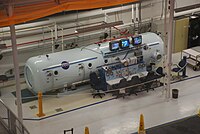
Photo from wikipedia
PURPOSE To evaluate the influence of atmospheric pressure changes on the behavior of intraocular pressure of healthy military individuals-students and instructors of the National Navy's Diving & Rescue School at… Click to show full abstract
PURPOSE To evaluate the influence of atmospheric pressure changes on the behavior of intraocular pressure of healthy military individuals-students and instructors of the National Navy's Diving & Rescue School at the "ARC BOLÍVAR" naval base-during a simulated immersion in the hyperbaric chamber of the Naval Hospital of Cartagena. METHODS A descriptive exploratory study was performed. The intraocular pressure was measured at different atmospheric pressures during 60-min sessions in the hyperbaric chamber while breathing compressed air. The maximum simulated depth was 60 feet. Participants were students and instructors of the Naval Base's Diving and Rescue Department. RESULTS A total of 48 eyes from 24 divers were studied, of which 22 (91.7%) were male. The mean age of the participants was 30.6 (SD=5.5) years, ranging from 23 to 40. No participant had a history of glaucoma or ocular hypertension. The mean base intraocular pressure at sea level was 14 mmHg, which decreased to 13.1 mmHg (decreased by 1.2 mmHg) at 60 feet deep (p=0.0012). However, during the safety stop at 30 feet, the mean IOP kept decreasing until reaching 11.9 mmHg (p<0.001). By the end of the session, the mean intraocular pressure reached 13.1 mmHg, which is inferior and statistically significant when compared with the intraocular pressure base mean (p=0.012). CONCLUSIONS In healthy individuals, the intraocular pressure decreases when reaching a depth of 60 feet (2.8 absolute atmosphere pressure) and it decreases even more during ascension at 30 feet. Measurements at both points were significantly different when compared with base intraocular pressure. The final intraocular pressure was lower than the baseline intraocular pressure, suggesting a residual and prolonged effect of the atmospheric pressure on intraocular pressure.
Journal Title: Arquivos brasileiros de oftalmologia
Year Published: 2023
Link to full text (if available)
Share on Social Media: Sign Up to like & get
recommendations!